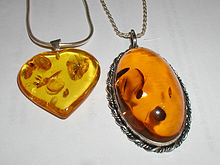Wikijunior:How Things Work/Electricity



The word Electricity comes from a Latin word meaning "like amber". Amber is the fossilized sap from ancient trees often used in jewellery. Electricity is the flow of charge in a conductor. A conductor is anything that can carry electricity (like a metal wire). Charge is the amount of electricity an object contains.
Who invented it?
editElectricity was discovered in 1600, by an English physician called William Gilbert. He made a careful study of electricity and magnetism. He differentiated between the lodestone effect (lodestones are natural magnetic stones) and the static electricity produced by rubbing amber. He was the first to use the word "electricity" in its modern sense.
How does it get power?
editElectricity is a type of energy. It supplies power to different objects to help them work. For example:
Electricity supplies energy to a computer and helps it work.
How does it work?
editEverything in the world is made up of atoms. An atom is made up of a nucleus (the tiny ball in the middle). The nucleus is made up of protons and neutrons. Protons have a positive charge while Neutrons have no charge at all. The small balls spinning around the nucleus are called "electrons" and have a negative charge. In an atom the positive and negative charge are exactly the same and so no electricity flows.
Due to this when the amber is rubbed, the outer electrons are removed and this makes the charge of the atom positive (because there are now more protons than electrons). This positive charge attracts anything with a negative charge (or other electrons that are part of different atoms).
How dangerous is it?
editElectricity in small quantities is not dangerous. But if the amount of electricity is big then it is very dangerous as it will give a very bad electric shock.
What does it do?
editElectricity supplies energy which helps many objects work.
How does it vary?
editYou can get different amounts of electricity from different sources. For example, a small battery only has a few volts of electricity, but the electrical sockets you have in your house can have up to 200 volts! This means that the sockets are much more dangerous, but also much more useful. You can't boil a kettle with a small battery, but you can if you plug the kettle into a socket.
How has it changed the world?
editElectricity replaced many dirty uses of fuels. For example, people used to burn gas in their homes for light, but electric lightbulbs replaced them as they were cheaper, safer, and didn't produce soot. Electric motors drive many industrial processes which previously would have needed an engine with fuel to drive.
There are also many uses for electricity that just can't be done any other way, like computers and TVs.
Due to electricity many people can move around quickly in electric cars. Computers, TVs, toasters and many more were created after electricity was discovered.
What idea(s) and/or inventions had to be developed before it could be created?
editMaking a little bit of static electricity is easy, but making lots of electricity is much harder. We needed to make metals before electricity could flow through them. We needed to understand atoms and chemistry before we could make good batteries.
Facts
edit- If you rub amber with silk, you may experience a tingling sensation (also called static electricity), and small things tend to 'stick' to the amber. This was probably ancient people's first experience with electricity.It is this attraction that makes the small bits of paper or cloth "stick" to the amber.
- A primitive form of electrical machine was constructed around 1663 by Otto von Guericke, using a sulphur globe that could be rotated and rubbed by hand, so detaching electrons mechanically. The easiest and most reliable way to detach electrons from their nucleus is to break them off using chemicals. or magnetism. We call these devices "cells" (or more usually in English "batteries") and generators.
- In 1791, Luigi Galvani hung some frogs' legs on a wire frame, and noticed that every time he did so, they twitched. He concluded that electricity was stimulating the nerve cells.
- Alessandro Volta found that cells connected together increased the power available, and he called that a voltaic pile or battery. This provided the early electrical scientists and engineers with a more reliable source of electrical energy than the electrostatic machines previously used.
- Georg Ohm mathematically analysed the electrical circuit in 1827.
- The first magnetic magneto or dynamo was built by Hippolyte Pixii in 1832, but, except for small units for bicycles they are no longer used for power generation due to the size and complexity of the rotating connections on the "commutator" between the fixed and rotating coils.
- Michael Faraday developed the "rotating rectangle",in which each active conductor passed successively through regions where the magnetic field was in opposite directions. The first public demonstration of a more robust "alternator system" took place in 1886, and this has remained the most common arrangement used in power-stations.
- The recognition of electromagnetism, the unity of electric and magnetic phenomena, is due to Hans Christian Ørsted and André-Marie Ampère some time between 1819-1820.
- All these people are honored by having electrical units or devices named after them.